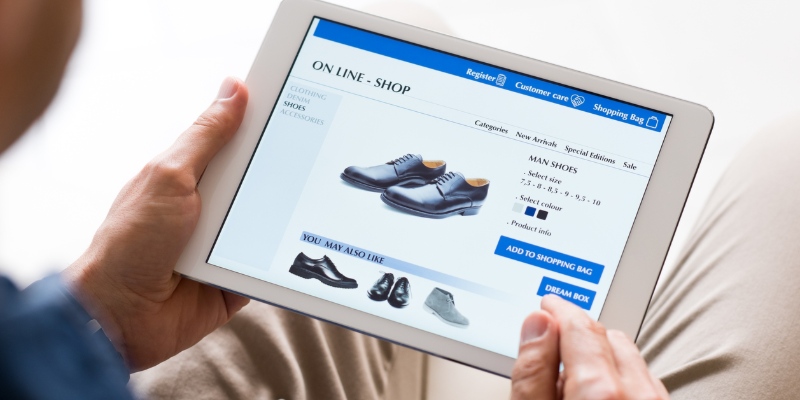October 20, 2025
E-Commerce vs Mobile Commerce: Key Differences, Trends & Strategy

In 2025, online shopping isn’t just about having a website; it’s about meeting your customers where they are. And more often than not, that means their phones.
So what’s the difference between e-commerce vs mobile commerce? And why should you care?
This blog breaks it down in simple terms. We’ll compare the two, look at real trends and numbers, and help you understand how going mobile-first could unlock serious growth for your brand.
If you’re selling online – whether it’s through Shopify or your own brand – you’ll want to see how this shift could change the way your customers shop (and how you sell).
Ready to dive in? Let’s go!
What is e-commerce?
E-commerce (electronic commerce) simply means buying and selling things over the internet. When someone visits your online store on a laptop, browses products, adds something to the cart, and checks out – that’s e-commerce in action.
It started with desktop websites and grew into what most of us use today: online stores, marketplaces like Amazon, and even social commerce on platforms like Facebook and Instagram. If it involves a screen and a transaction, it’s part of the e-commerce world.
Most e-commerce sites are built to work on different devices, but they’re usually designed with desktop browsing in mind. That’s why, even today, many mobile shoppers end up abandoning their carts – because the experience doesn’t always feel smooth or intuitive on smaller screens.
E-commerce opened the door to online shopping. But now, with mobile usage booming, that door is wide open, and m-commerce is walking right through it.

What is mobile commerce?
Mobile commerce, or m-commerce, is a type of e-commerce, but it happens entirely on mobile devices like smartphones and tablets.
Shopping happens through mobile apps, mobile-optimized websites, and quick checkouts using Apple Pay or Google Pay. It’s all designed to be fast, seamless, and perfectly suited to how people shop on their phones today – on the move, in short bursts, and with little patience for anything slow or clunky.
M-commerce goes beyond just making a website mobile-friendly. It’s about designing the entire shopping experience around mobile behavior: bigger buttons, one-hand navigation, quick load times, and easy checkout flows. It also taps into native features like push notifications, in-app messages, and location-based offers that just aren’t possible on desktop.

E-commerce vs mobile commerce: A feature-by-feature comparison
Now that we’ve defined both, let’s break down how e-commerce and mobile commerce stack up side by side. While they both let customers buy online, the experience and the results can be very different.
| Feature | E-commerce | M-commerce |
| Definition | Buying and selling goods/services over the internet. | Buying and selling via mobile devices using wireless networks. |
| Devices | Accessed on desktops, laptops, tablets, and smartphones. | Focused on smartphones and tablets only. |
| Platforms | Websites, marketplaces, auctions, and social commerce platforms. | Mobile apps and mobile-optimized websites. |
| User experience | Designed mainly for larger screens; may not always translate well to mobile. | Touch-friendly UI, faster navigation, built for small screens and short sessions. |
| Checkout process | Standard multi-step checkout forms; may require manual input. | One-tap checkout, mobile wallets (Apple Pay, Google Pay), autofill support. |
| Connectivity | Requires stable internet connection. | Often optimized for variable mobile networks; some features work offline in apps. |
| Marketing channels | SEO, email marketing, social media, PPC, on-site promotions. | Push notifications, SMS marketing, app-based promotions, location-based services. |
| Personalization | Basic product recommendations based on site behavior. | Deep personalization using app data, behavior tracking, and mobile analytics. |
| Security | Secure payments via standard gateways and SSL. | Enhanced with biometric authentication, app security, and encrypted wallets. |
| Adoption trends | Stable growth, especially in B2B and higher-ticket categories. | Rapid growth, especially in DTC and consumer retail. |
| Focus | Broad category covering all types of online transactions. | Mobile-specific transactions with a focus on speed, convenience, and reachability. |
As you can see, mobile commerce isn’t just a smaller version of e-commerce. It’s a different experience altogether – faster, more personal, and more integrated with how people live and shop today.
This is exactly why brands that go mobile-first are seeing better engagement and more conversions, especially when they use tools that are built specifically for mobile users.
Numbers that talk: Mobile commerce vs e-commerce growth
Over the past few years, mobile commerce has been growing faster than desktop e-commerce. In fact, mobile now makes up the majority of online shopping traffic, and it’s quickly catching up in actual purchases, too.
Here’s what the trends are showing:
- 72% of all e-commerce sales are expected to come from mobile in 2025.
- Mobile users browse more often and buy more frequently when the experience is smooth.
- Mobile wallets like Apple Pay, Google Pay, and Shop Pay are becoming the default checkout methods for younger shoppers.
Compare that to desktop e-commerce, which still has its place but is growing at a slower pace. Many users still start their search on desktop, but they finish the purchase on mobile.

Why this matters for your business
If your store feels clunky on mobile or isn’t built for how people shop on their phones, you’re likely losing sales without even realizing it.
Brands that invest in a mobile-first or app-based experience are seeing:
- Lower bounce rates
- Higher conversion rates
- Stronger customer retention (thanks to tools like push notifications and in-app loyalty)
And that’s why mobile commerce isn’t just a trend; it’s the new standard. For brands looking to scale, getting mobile right is no longer optional.
Why mobile commerce is winning in 2025
So why is mobile commerce pulling ahead so fast? It’s not just about convenience; it’s about how people live, shop, and connect today.
Think about it: phones are always within reach. We scroll while commuting, waiting in line, watching TV. And brands that meet us in those moments, without friction, are the ones we remember (and buy from).
Here’s why mobile commerce is leading the charge in 2025:
1. It’s designed for real life
Mobile commerce experiences are built for busy, on-the-go users. Navigation is simple, product images are swipeable, and checkout is lightning fast. No zooming, no pinching, no frustration.
2. Frictionless payments
Mobile wallets like Apple Pay, Shop Pay, and Google Pay mean fewer steps – and fewer drop-offs. The fewer fields customers have to fill, the more likely they are to complete the purchase.
3. Push notifications drive engagement
Unlike desktop e-commerce, mobile commerce lets you stay in touch in real time. A flash sale, a back-in-stock alert, or a gentle reminder can land right on your customer’s lock screen.
4. Stronger loyalty through apps
Mobile apps allow for personalized experiences, in-app rewards, and faster reordering, turning one-time buyers into repeat customers.
5. Data-driven personalization
Mobile commerce makes it easier to collect behavior data and tailor recommendations. The result? Shoppers feel seen and are more likely to come back.

When e-commerce still wins (and why that’s okay)
We’ve talked a lot about mobile, but let’s be real: desktop e-commerce isn’t dead.
In fact, there are still plenty of situations where a traditional e-commerce site shines.
Here’s when desktop still makes sense:
- Higher-ticket or complex products: Products like furniture, B2B tools, or software often need more research before buying. Customers usually prefer using a larger screen to compare options and make confident decisions.
- Multi-tab browsing: Some shoppers prefer to explore multiple options side by side, especially when making thoughtful purchases.
- Work-time shopping: Many people shop from their desktops during work breaks or lunch hours.
- Admin and backend workflows: Store owners and marketers still manage most backend tasks – like reporting, analytics, and inventory – from desktop dashboards.
The takeaway? It’s not either/or. It’s about meeting customers where they are.
For many brands, the best strategy is a hybrid approach: strong e-commerce fundamentals paired with a mobile-first (or app-based) layer that unlocks speed, loyalty, and deeper engagement.

Pros and cons of mobile commerce vs e-commerce
Now that we’ve looked at when each model works best, let’s break it down even further.
Here are the key advantages and limitations of e-commerce and mobile commerce, so you can decide which fits your brand’s goals today (and where you might want to go next).
Pros and cons of e-commerce
| Advantages | Disadvantages |
| ✅ Accessible across all devices ✅ Familiar for many customers ✅ Better for complex or high-ticket products | ❌ Can be clunky on mobile if not optimized ❌ Lower engagement without native tools (e.g., push) |
Pros and cons of mobile commerce
| Advantages | Disadvantages |
| ✅ Fast, intuitive shopping on the go ✅ Higher engagement via push, SMS, and app features ✅ Better mobile conversion rates | ❌ Limited space for detailed content ❌ Can require more development (if building a full app) |
Strategic recommendations: How to choose the right channel
By now, you know the differences between e-commerce vs mobile commerce, and the opportunity. But what does that mean for your brand?
Here’s how to think about choosing the right approach (or mix) based on where you are now:
If you’re just getting started
Stick with a responsive e-commerce site, but make sure it’s mobile-optimized from day one. Use lightweight themes, compress your images, and test the mobile checkout experience often.
| 💡 Start simple. Build a foundation that won’t break when traffic starts scaling. |
If you’re a growing DTC brand
You’re likely seeing most of your traffic come from mobile, but conversions may be lagging. This is your cue to go mobile-first. Whether it’s building a mobile app or enhancing the mobile site with app-like experiences, it’s time to make the switch.
| 💡 Your customers are already mobile; you just need to meet them there. |
If you’re a Shopify agency or freelancer
Your clients want results. Recommending mobile-first tools like OneMobile adds value to your service and helps them stay competitive. It also makes you look good when conversions go up.
| 💡It’s a win-win. Better performance for them, stronger retention for you. |
If you’re scaling with repeat customers
Apps can drive loyalty, faster checkouts, and direct communication through push notifications. They’re perfect for brands with strong communities or frequent purchases (like beauty, fashion, food, and wellness).
| 💡Think of it as your brand’s personal storefront in your customer’s pocket. |
In short: mobile commerce isn’t about replacing e-commerce; it’s about upgrading it.
The brands that make this move now? They’re the ones leading the pack tomorrow.
Wrap it up
E-commerce vs mobile commerce aren’t competing; they’re evolving together. But in today’s landscape, mobile is clearly taking the lead.
More traffic, more conversions, and deeper engagement are all happening on mobile devices. And that means your brand needs more than just a mobile-friendly site; it needs a mobile-first mindset.
If you’ve been waiting for a sign to upgrade your mobile experience, this is it.
Because the brands that move now?
They’ll be the ones customers remember – and return to.
Table of Contents
Table of Contents
Read more articles
How To Advertise Your Mobile App During Pre-Launch, Launch and Post-Launch Stage
By Alexandre Le
October 21, 2025
14 Common Apple App Store Rejections and How To Avoid Them
By Alexandre Le
October 21, 2025







